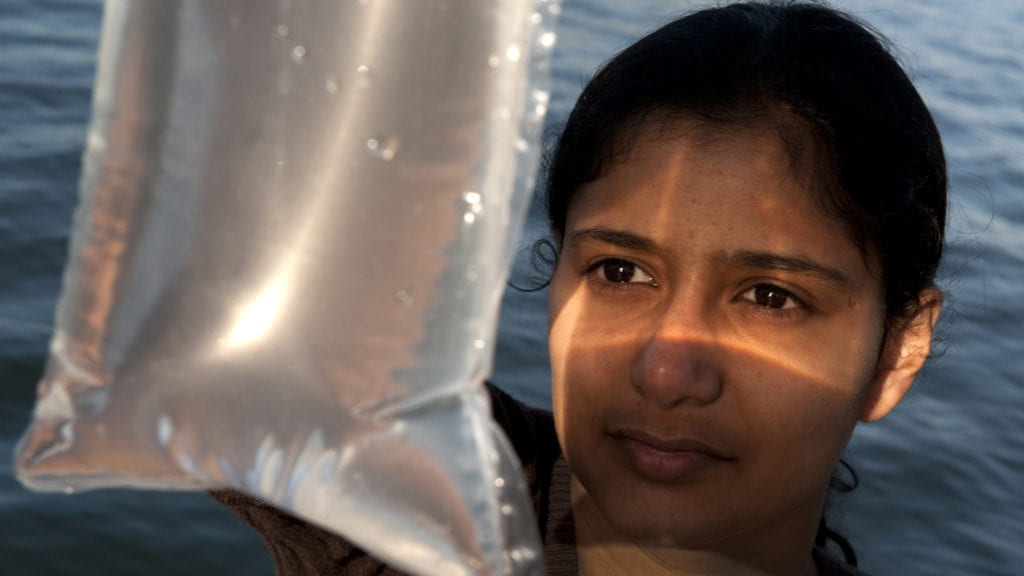Is the ocean making you sick?
This summer, surfers and swimmers will risk more than sunburn — the ocean could make them sick. UCI researchers are testing the waters and working to improve the detection, identification, measurement and elimination of coastal pollutants.
Sunny Jiang, a UC Irvine researcher studying pollution in Orange County’s coastal waters, recently got a graphic look at how swimming and surfing in the ocean can make people sick.
She and a team of graduate students charted incidents of poor water quality at Southern California beaches over a 10-year period and the number of ocean-related illnesses reported at the Surfrider Foundation website during the same timeframe. Each graph looked like a series of waves, and when the two were overlapped, their peaks and valleys matched up perfectly.
“The correlation was more than 96 percent,” says Jiang, associate
professor of civil & environmental engineering. “It’s another
indication that water quality definitely affects human health.”
For
those who play in the ocean off California’s coast, pollution has
proved to be a major bummer. High concentrations of disease-carrying
bacteria have led to beach closures, sickened marine mammals and birds,
and caused a host of illnesses in humans. Catch a wave and you could
come down with a respiratory illness, rash or gastroenteritis, the
unpleasant bout of vomiting and diarrhea associated with drinking
contaminated water in Third World countries. It’s no day at the beach.
“I talk to a lot of surfers,” says Jiang, who occasionally surfs and
scuba dives. “Everyone has a story about getting sick from surfing, but
if you look for real data, there’s a gap. We haven’t quantified the
risk. We haven’t explored the relationship between pathogens and their
effect on people.”
Located
minutes from some of the world’s prime surf spots, UCI is home to
researchers like Jiang and Stanley Grant, chemical engineering &
materials science professor, who’ve been working to change that.
Grant
has been on a one-year sabbatical to study the role of urban
communities in coastal pollution. “My goal was to write at least one
paper that did not have ‘fecal’ in the title,” he jokes.
It’s
not exactly the stuff of great dinner party conversation: He studies
fecal pollution in surface waters to determine its sources. This can be
challenging, because there are often multiple culprits, some — like
sewage spills — related to human activity and some not — like bird
droppings.
“I started this work 12 years ago. The Huntington Beach closures in
1999 piqued my interest,” Grant says. “The collective response from
other researchers was, ‘Why would you study that?’ It seemed like a
local problem.
“Over
time, as we tried to understand what was going on in coastal waters,
people became more interested. We’ve developed a little field of
researchers who take this very seriously. It’s impactful — this is
where we live and recreate. It’s the interface between the ocean and
our built environment.”
Grant’s research has already yielded results: His team investigated
pollution in Avalon Bay, a popular tourist destination on Catalina
Island, and found that the city’s old, corroded sewer lines were
leaking bacteria into the groundwater, which then seeped into the bay.
“Avalon
spent millions fixing them,” Grant says. “This is a concern in many
places, but no one wants to spend money on sewer lines. A lot of
infrastructure is decaying. It leads to sewage overflows and
contamination.”
It’s
especially risky to swim in the ocean after heavy rains, when storm
drains can dump toxic urban runoff directly into coastal waters.
“Unfortunately, a lot of hard-core surfers are right there after a storm because the waves are the biggest,” Jiang says.
Bacteria and viruses can be ingested when swimmers or surfers swallow seawater or inhale foam or spray.
Currently, beaches are declared unfit for swimming when the
concentration of fecal indicator bacteria exceeds state standards.
(Beach report cards can be found on the Heal the Bay website.)
But detection methods are slow; warnings might not be posted until 48 hours after a pollution spike.
“We
need a more rapid monitoring system so beach pollution is in sync with
water quality reports,” Jiang says. “It doesn’t do any good to issue
warnings two days late. By that time the water might be clear, but
anyone who went surfing the day before could have been exposed.”
Her
group has developed a quick method of tracking bacteria and viruses in
the water that’s currently under review by the Environmental Protection
Agency. If it’s approved, county health departments could test the
waters and issue timely warnings to beachgoers, Jiang says.
“The
ocean is an important resource,” she says. “The more we understand the
risks, the more we can use it wisely.” And paddle out when the surf’s
up without fear of coming down with anything.

